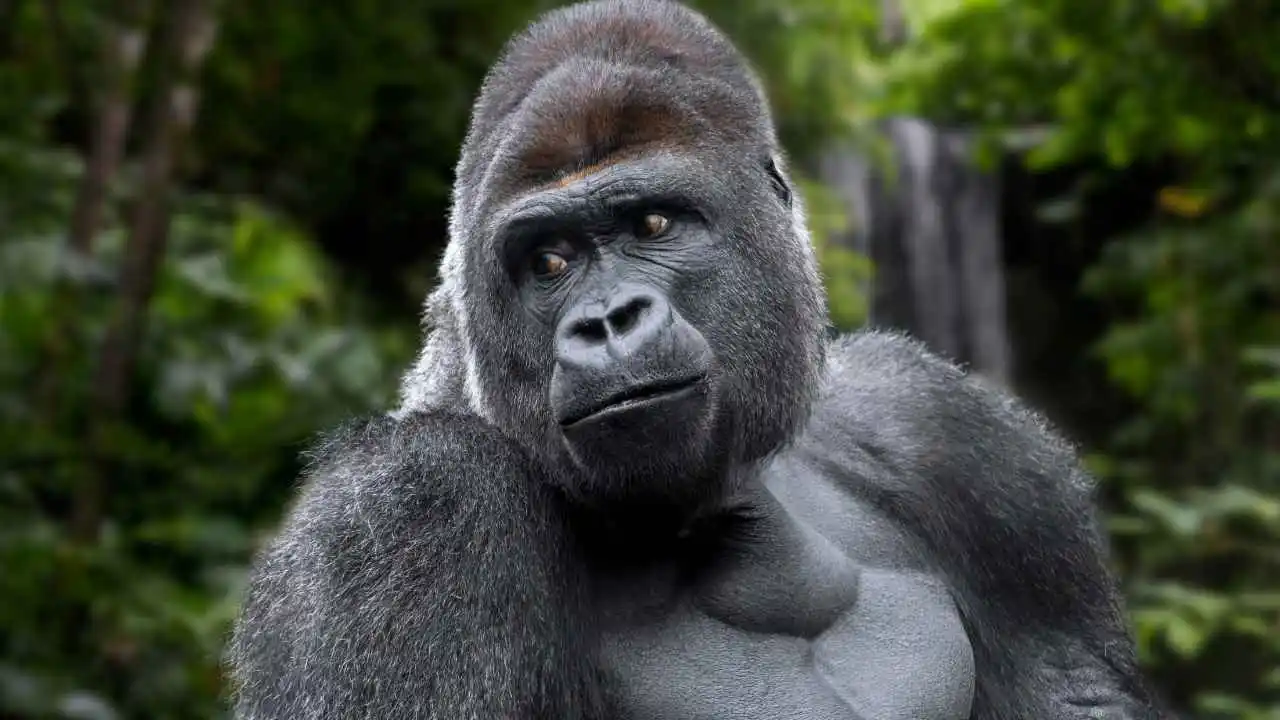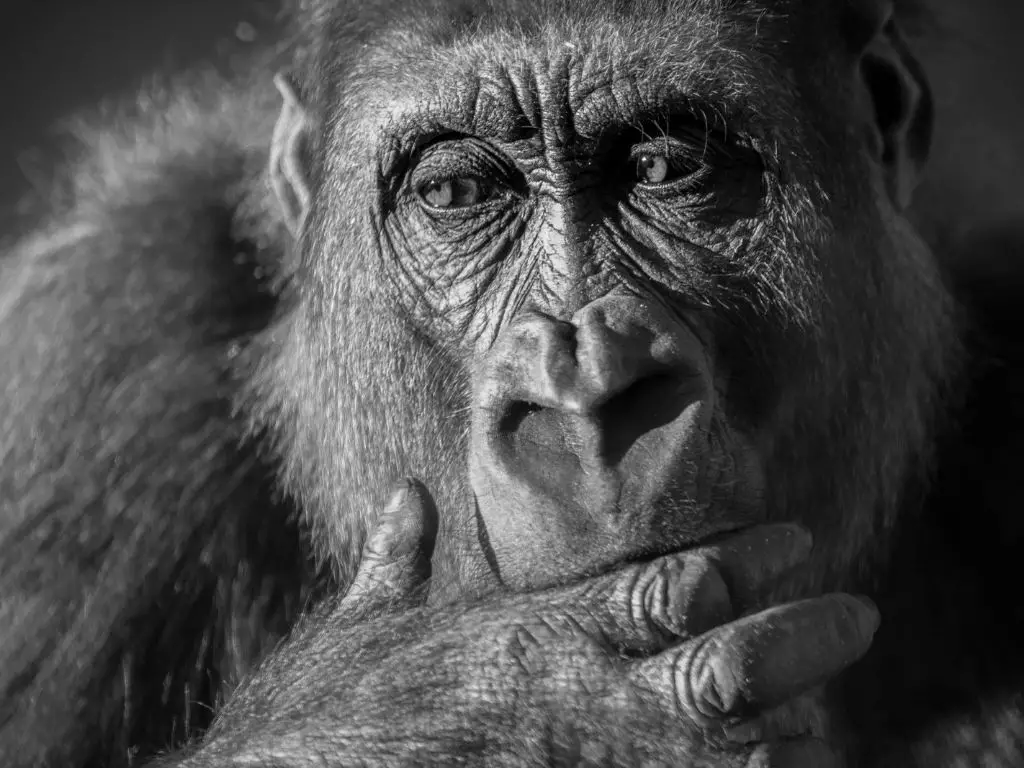Silverback gorillas are not just any ordinary members of the gorilla family; they are the true leaders and protectors of their groups. IThese gorillas are named ‘silverback’ because of the distinctive silver fur on their backs, a sign of maturity and wisdom. They are the oldest and strongest males in the group, often seen leading, making decisions, and even settling disputes within their families. t is their size and strength which makes them lead their group. In this article we will find out how much does a silverback gorilla weigh, their physical characteristics, average weight, heaviest silver back gorilla ever and many other intersting information for you to read.
How Much Does A Silverback Gorilla Weigh
Physical Characteristics of Silverback Gorillas

When it comes to size, silverback gorillas are truly impressive. They are much larger and more muscular than their female counterparts, with a broad chest and shoulders, large hands, and forearms that show off their strength. An adult silverback can stand up to 5.5 feet when upright, although they usually walk on all fours.
What really sets silverbacks apart is their striking silver hair along their back and hips, which develops as they grow older, usually around 12 years of age. This silver hair is like a badge of honor, showing their age, wisdom, and rank within the group.
Compared to other gorilla subspecies, silverbacks are generally larger and more robust. While all gorillas share a family resemblance, silverbacks have a more pronounced crest on their heads, known as a sagittal crest, which is a sign of their strength, as it’s where the muscles for chewing attach.
Average Weight of Silverback Gorillas

Silverback gorillas are known for their impressive size. On average, these magnificent creatures weigh between 300 to 500 pounds. However, their weight can vary quite a bit, influenced by several factors.
Age plays a significant role in a silverback’s weight. Like humans, young gorillas are much lighter, and they gain weight as they grow older and mature into the role of a silverback.
Diet is another crucial factor. Silverback gorillas primarily eat plants, including leaves, stems, and fruits, which provide them with the necessary nutrients to maintain their large size. However, the availability and variety of food in their habitat can affect their weight. For instance, gorillas with access to a rich, diverse diet tend to be heavier.
Habitat also influences their weight. Gorillas living in lush, food-rich forests may have a different body mass compared to those in more sparse environments. Additionally, gorillas in captivity often weigh more than their wild counterparts due to regular feeding and less physical activity.
Record Weights and Exceptional Cases

While the average weight of silverback gorillas is already impressive, there have been some exceptional cases. The heaviest silverback gorilla ever recorded was a captive gorilla named Phil, who lived at the St. Louis Zoo and weighed an astonishing 860 pounds. This weight is almost double the average for a wild silverback.
Several factors contribute to such exceptional weights, especially in captivity. Diet in zoos is often more calorie-rich and consistent than in the wild, leading to greater weight gain. Lack of exercise in captivity also plays a role, as wild gorillas roam large territories and are more active, which helps regulate their weight.
However, it’s important to note that being overweight can be as much of a health concern for gorillas as it is for humans. Maintaining a healthy weight is crucial for their overall well-being, whether in the wild or in captivity.
Diet and Nutrition

The diet of a silverback gorilla plays a pivotal role in its health and weight. These magnificent creatures are predominantly herbivorous, meaning their diet mainly consists of plant-based foods. They feast on a variety of leaves, stems, fruit, and occasionally indulge in small insects or grubs. This diet is high in fiber and low in fat, which is essential for maintaining their robust size and health.
In the wild, the availability of food can vary, influencing a gorilla’s nutrition and weight. During seasons when food is abundant, they might gain weight, while in leaner times, they might lose some. In captivity, their diet is carefully managed to ensure they get all the necessary nutrients without becoming overweight.
Growth and Development

The journey from infancy to becoming a silverback is a fascinating transformation. Baby gorillas are born weighing about 4 pounds, quite small compared to their adult size. In their early years, they experience rapid growth, much like human children.
As young males grow into juveniles and then teenagers, known as ‘blackbacks’, they start to gain significant muscle mass and weight. This growth is gradual and continues until they are about 12 to 15 years old, when they reach full maturity and are considered silverbacks. At this stage, they develop the silver strip of hair on their back, signifying their status as the dominant male of the group.
During this growth phase, a male gorilla’s weight can more than double. Their physicality also changes – they develop broader chests, stronger arms, and a more pronounced sagittal crest, which is indicative of their strength and maturity.
This growth and development are influenced by genetics, diet, and overall health. It’s a crucial period that determines the kind of adult the young gorilla will become, both in terms of physicality and social status within the group.
Physical Strength and Capabilities
The impressive weight of a silverback gorilla is directly linked to its remarkable strength. These animals are incredibly powerful, with the ability to lift and break heavy objects that humans could only dream of moving. Their muscular build, especially in their arms and chest, contributes to their ability to climb, fight, and protect their group. For example, a silverback can effortlessly bend and snap thick, sturdy branches, a testament to their brute strength.
Environmental and Genetic Factors
Both environment and genetics play significant roles in the size and weight of silverback gorillas. Genetically, gorillas inherit traits from their parents that influence their potential size and strength. However, the environment, including the availability of food and the need for physical activity, can greatly impact their actual development. Wild gorillas, who roam vast territories and have varied diets, often differ in size and weight from their captive counterparts, who may have less room for movement and more consistent food supplies.
Conservation Status
Silverback gorillas are currently facing numerous challenges that threaten their survival, leading to their classification as endangered species. Habitat destruction, poaching, and diseases are significant threats to their populations. Conservation efforts are crucial in protecting these magnificent creatures and their habitats. By preserving their natural environments and reducing human-induced threats, we can help maintain healthy populations of silverbacks in the wild.
Human Impact and Gorilla Health
Human activities, such as deforestation, mining, and agriculture, have a profound impact on gorilla habitats, affecting their health and survival. These activities not only reduce their living space but can also lead to food shortages and increased contact with humans, which can lead to conflict and the spread of diseases. Conservation efforts, including habitat protection, anti-poaching patrols, and public education, are essential in mitigating these negative impacts.
Conclusion
Understanding the weight and physicality of silverback gorillas is more than just an academic interest; it’s crucial for their conservation and our education. By comprehending how factors like diet, environment, and human activity affect these animals, we can better appreciate their needs and the challenges they face. This knowledge is vital in guiding conservation efforts and ensuring that future generations can continue to learn from and be inspired by these magnificent creatures. The health and survival of silverbacks are intricately linked to the health of our planet, reminding us of the importance of coexisting harmoniously with nature.





Leave a Reply